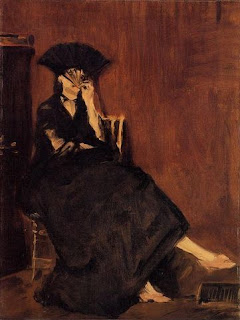Wednesday, April 7th, 2010
Morisot and Manet
Anyhow, I have read far enough in the book to learn more about the relationship between Manet and Berthe Morisot, a female Impressionist painter. Morisot posed in several of Manet’s portraits, and it is often thought that the two were romantically interested in each other (although Manet was already married and Morisot eventually became engaged to Manet’s brother). Manet’s painting on the left, The Balcony (1868-69) was the first painting for which Morisot posed (she is seated in the foreground). Since I am interested in this Manet/Morisot relationship, I was excited to see that today heidenkind mentioned an interesting article on this topic (see her fun post which “interviews” Manet).
The article, “Unmasking Manet’s Morisot” by Marni R. Kessler visually analyzes portraits of Morisot by Manet. Kessler points out that the “crucial significance of Manet’s depictions of Morisot lies in…continual shifting identity: [Morisot] looks different from canvas to canvas.”1 It is especially interesting to see how Morisot’s portraits morph over time, especially as Morisot’s relationship progressed with Manet’s brother. Morisot’s features continually become harsher in the paintings, and she is depicted with increasingly violent brushstrokes. Take a look at these following paintings, which are posted chronologically:
Pretty interesting, huh? It seems that the depictions of Morisot don’t reflect changes in her actual appearance too, since she also painted self-portraits at the time. Instead, one can visualize Manet’s frustration and sense of loss as Morisot becomes engaged to Manet’s brother. I would really recommend that you read Kessler’s detailed analysis of these paintings – they are quite fascinating.
This article explores a lot of other interesting ideas, such as Kessler’s argument that a sense of artistic rivalry is manifest in these same portraits: interestingly, Manet never chose to depict Morisot in the act of painting. Instead of a reference to her accomplishments as a painter, all of these portraits emphasize Morisot’s gender and femininity in one way or another.3
Anyhow, this is an interesting article, and I wholeheartedly recommend it.
1 Marni R. Kessler, “Unmasking Manet’s Morisot,” The Art Bulletin 81, no 3 (September 1999): 475.
2 Ibid., 482.
3 Ibid., 477-478.






VERY interesting. Private Lives is one book I've been wanting to read as well! I think I started it a few years ago, but dropped it for some reason…I'll have to try again.
Fascinating! I love the whole idea of it — a love triangle, passionate artists, jealousy, intrigue, unflattering paintings! It's almost like an episode of "90210" or something … only without theme music and Tori Spelling.
Thanks for sharing the article. Really cool.
Berthe Morisot was Manet's pupil. He had an obligation to protect her!
It is interesting that in The Balcony 1868, where Morisot looks young and fresh, there is no mention of her name in the painting's title. Even in Le Repos 1870, where she still looks good, her name was only appended afterwards.
Yet by 1874, when the grotesque versions of her portrait emerged, her name was clearly in each title. There was no need for Manet to do that. Noone would have known who the sitter was, hidden behind veils and fans. He was just being nasty.
I know how you feel about the pile of reading on the bedside table. It builds up and up, glaring at you nightly for not getting the job done 🙂
Yay, it's Manet day! ^__^
I love Kessler's article, too. One of the better articles I managed to find for my class I think. And I got Private Lives of the Impressionists to read a while ago, but I've completely lost the motivation. 😛
Cool! I am intrigued by this relationship. I blogged about it some time ago. I have NEVER seen the miserable portraits of her. The books sounds very interesting. I like Hels comment that for the first time Manet used Berthe's name in the title.
Thanks for the comments, everyone. Hels, I also like your observation about how Morisot's name intentionally appears in the later titles of the paintings. How interesting.
I have never really classified Morisot as a student of Manet (I've always considered Eva Gonzales to be Manet's only formal student), but I see what you are saying, Hels.
Great post! It's nice to discover others who have a something of a passion for the lives and relationships of the artists of this era. I enjoyed reading The Private Lives of the Impressionists. And with a special interest in Morisot after seeing an small exhibition with her work I read Shennan's "Berthe Morisot: The First Lady of Impressionism" which gives a detailed insight into her life and relationship with the Manets. Have you read it? Considering Manet himself and the Paris in which he lived I also enjoyed reading The Judgement of Paris.
Always on the lookout for good books on the lives of these (and other) artists, I'd gladly receive tips for further reading.
Kind regards.